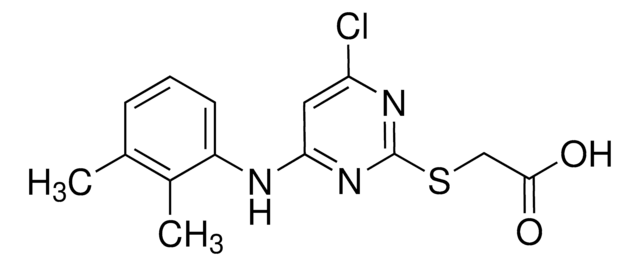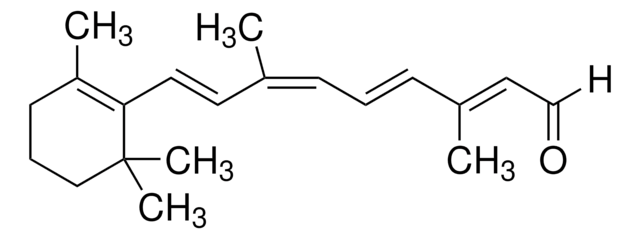R0635
Retinylacetat – wasserlöslich
BioReagent, suitable for cell culture
Synonym(e):
Retinylacetat, Retinolacetat, Vitamin A-acetat
About This Item
Empfohlene Produkte
Biologische Quelle
synthetic (organic)
Produktlinie
BioReagent
Form
powder
Methode(n)
cell culture | mammalian: suitable
Farbe
white to light yellow
mp (Schmelzpunkt)
57-58 °C
Löslichkeit
H2O: 400 mg/mL
Lagertemp.
−20°C
SMILES String
CC1=C(/C=C/C(C)=C/C=C/C(C)=C/COC(C)=O)C(C)(C)CCC1
InChI
1S/C22H32O2/c1-17(9-7-10-18(2)14-16-24-20(4)23)12-13-21-19(3)11-8-15-22(21,5)6/h7,9-10,12-14H,8,11,15-16H2,1-6H3/b10-7+,13-12+,17-9+,18-14+
InChIKey
QGNJRVVDBSJHIZ-QHLGVNSISA-N
Suchen Sie nach ähnlichen Produkten? Aufrufen Leitfaden zum Produktvergleich
Allgemeine Beschreibung
Anwendung
Biochem./physiol. Wirkung
Verpackung
Alternative Formulierung
Ähnliches Produkt
Signalwort
Danger
H-Sätze
Gefahreneinstufungen
Repr. 1B
Lagerklassenschlüssel
6.1C - Combustible acute toxic Cat.3 / toxic compounds or compounds which causing chronic effects
WGK
WGK 3
Flammpunkt (°F)
Not applicable
Flammpunkt (°C)
Not applicable
Persönliche Schutzausrüstung
Eyeshields, Gloves, type N95 (US)
Analysenzertifikate (COA)
Suchen Sie nach Analysenzertifikate (COA), indem Sie die Lot-/Chargennummer des Produkts eingeben. Lot- und Chargennummern sind auf dem Produktetikett hinter den Wörtern ‘Lot’ oder ‘Batch’ (Lot oder Charge) zu finden.
Besitzen Sie dieses Produkt bereits?
In der Dokumentenbibliothek finden Sie die Dokumentation zu den Produkten, die Sie kürzlich erworben haben.
Kunden haben sich ebenfalls angesehen
Unser Team von Wissenschaftlern verfügt über Erfahrung in allen Forschungsbereichen einschließlich Life Science, Materialwissenschaften, chemischer Synthese, Chromatographie, Analytik und vielen mehr..
Setzen Sie sich mit dem technischen Dienst in Verbindung.








